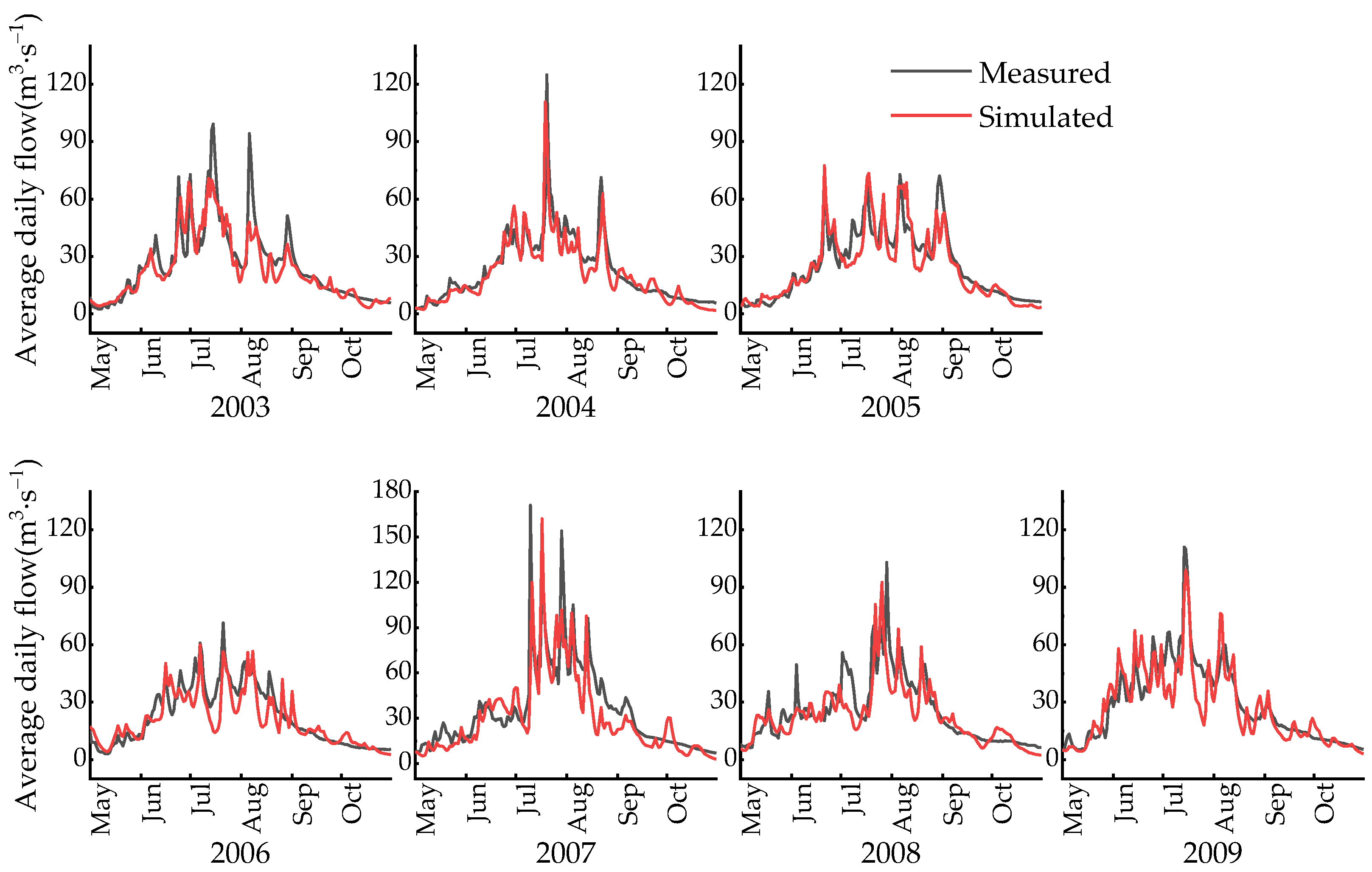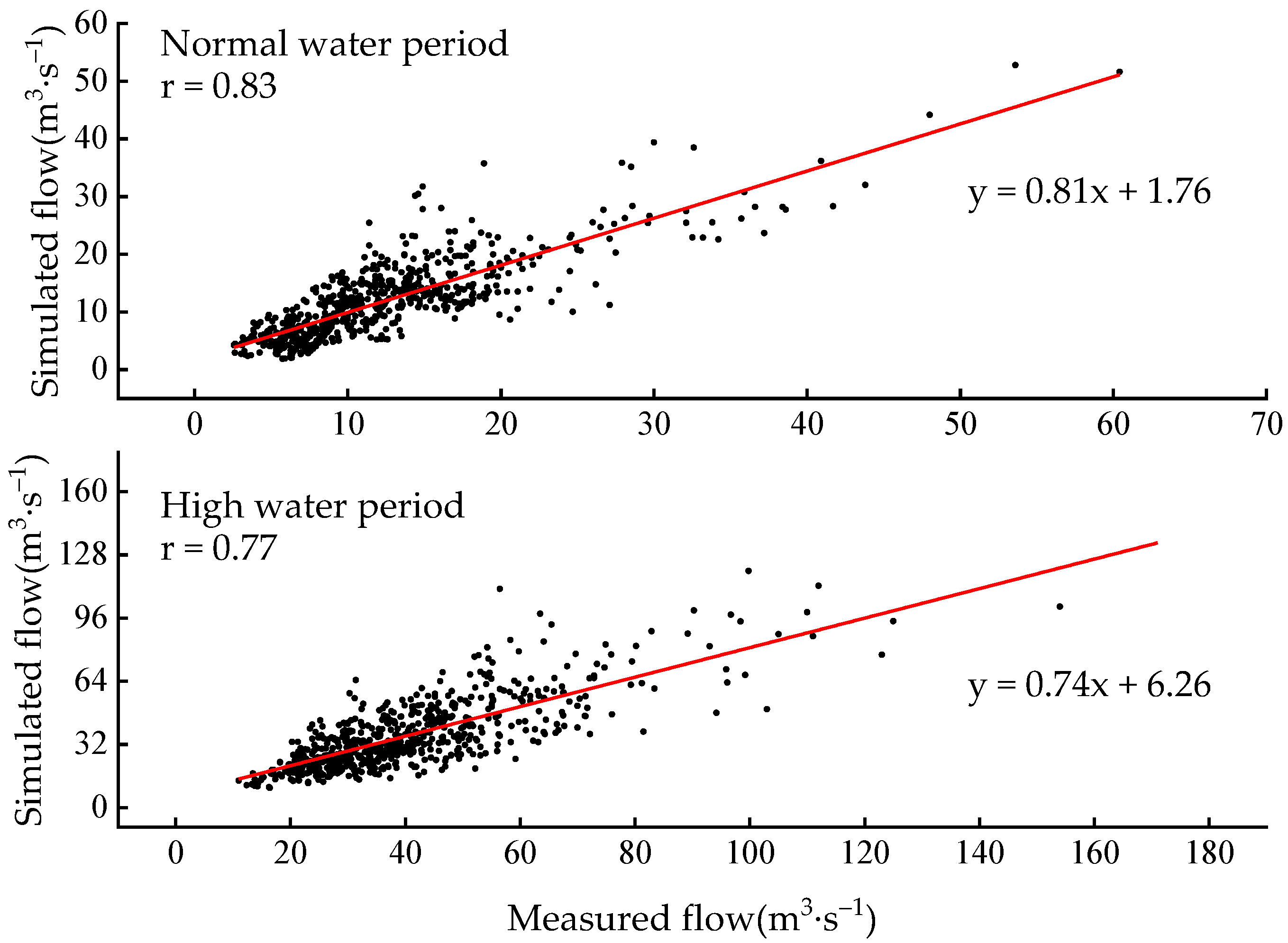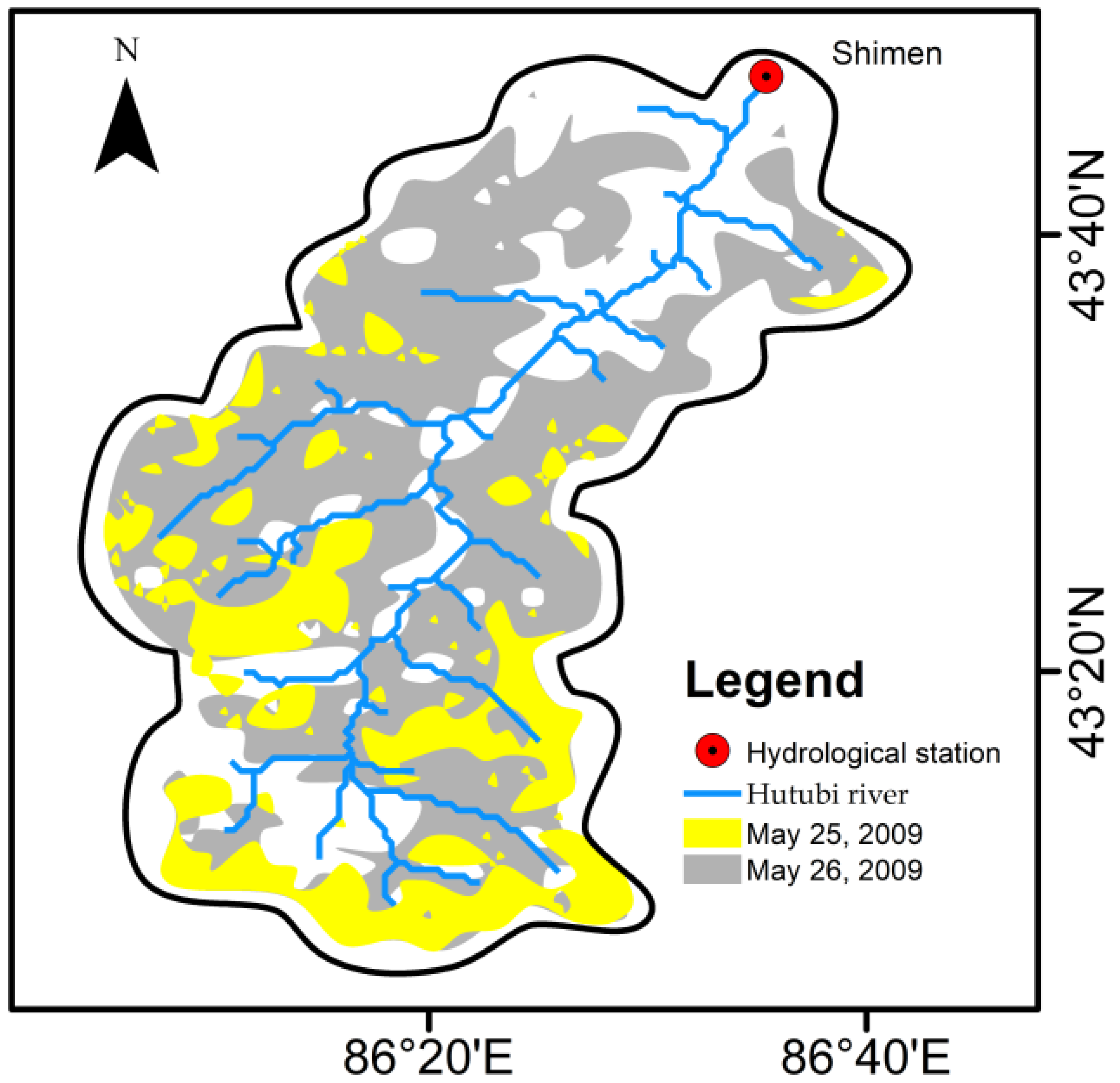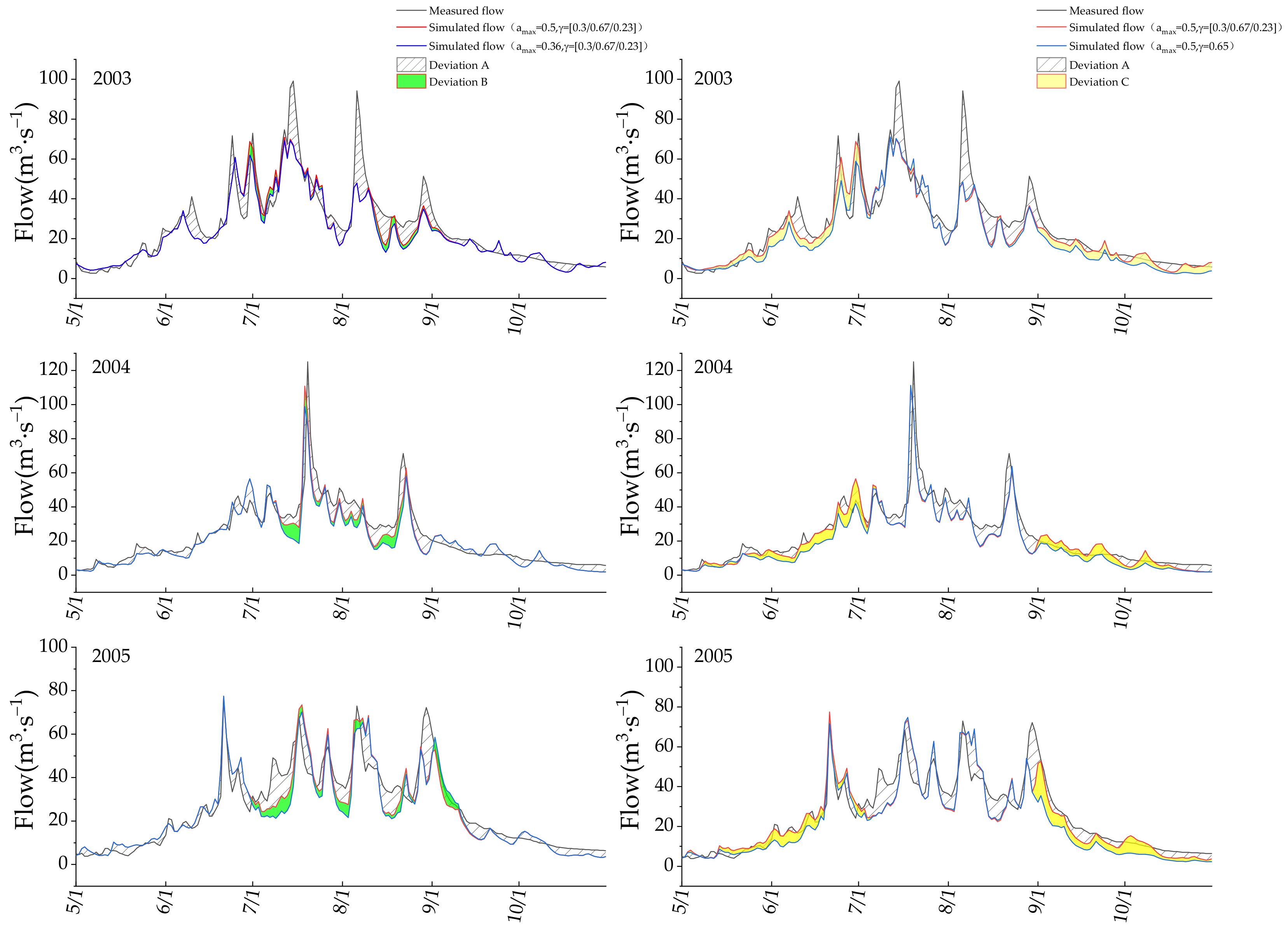Adaptability of MODIS Daily Cloud-Free Snow Cover 500 m Dataset over China in Hutubi River Basin Based on Snowmelt Runoff Model
Abstract
:1. Introduction
2. Materials and Methods
2.1. Study Area
2.2. Materials
2.3. SRM and Parameter Determination
2.3.1. Model Structure
2.3.2. Elevation Zone
2.3.3. Model Variables
2.3.4. Model Parameters
3. Results
3.1. Snow Cover Characteristics
3.2. Runoff Characteristics
3.3. Simulation Accuracy Evaluation
4. Discussion
4.1. Impact of Extreme Weather Events on Runoff
4.2. Uncertainty Analysis and Optimization
5. Conclusions
Author Contributions
Funding
Institutional Review Board Statement
Informed Consent Statement
Data Availability Statement
Acknowledgments
Conflicts of Interest
References
- Barnett, T.P.; Adam, J.C.; Lettenmaier, D.P. Potential impacts of a warming climate on water availability in snow-dominated regions. Nature 2005, 438, 303–309. [Google Scholar] [CrossRef] [PubMed]
- Lievens, H.; Demuzere, M.; Marshall, H.P.; Reichle, R.H.; Brucker, L.; Brangers, I.; de Rosnay, P.; Dumont, M.; Girotto, M.; Immerzeel, W.W.; et al. Snow depth variability in the Northern Hemisphere mountains observed from space. Nat. Commun. 2019, 10, 4629. [Google Scholar] [CrossRef] [PubMed]
- Immerzeel, W.W.; van Beek, L.P.; Bierkens, M.F. Climate change will affect the Asian water towers. Science 2010, 328, 1382–1385. [Google Scholar] [CrossRef] [PubMed]
- Immerzeel, W.W.; Lutz, A.F.; Andrade, M.; Bahl, A.; Biemans, H.; Bolch, T.; Hyde, S.; Brumby, S.; Davies, B.J.; Elmore, A.C.; et al. Importance and vulnerability of the world’s water towers. Nature 2020, 577, 364–369. [Google Scholar] [CrossRef]
- Biemans, H.; Siderius, C.; Lutz, A.F.; Nepal, S.; Ahmad, B.; Hassan, T.; von Bloh, W.; Wijngaard, R.R.; Wester, P.; Shrestha, A.B.; et al. Importance of snow and glacier meltwater for agriculture on the Indo-Gangetic Plain. Nat. Sustain. 2019, 2, 594–601. [Google Scholar] [CrossRef]
- Vuille, M.; Carey, M.; Huggel, C.; Buytaert, W.; Rabatel, A.; Jacobsen, D.; Soruco, A.; Villacis, M.; Yarleque, C.; Elison Timm, O.; et al. Rapid decline of snow and ice in the tropical Andes—Impacts, uncertainties and challenges ahead. Earth-Sci. Rev. 2018, 176, 195–213. [Google Scholar] [CrossRef] [Green Version]
- Hagg, W.; Braun, L.N.; Weber, M.; Becht, M. Runoff modelling in glacierized Central Asian catchments for present-day and future climate. Hydrol. Res. 2006, 37, 93–105. [Google Scholar] [CrossRef] [Green Version]
- Chen, Y.; Li, W.; Deng, H.; Fang, G.; Li, Z. Changes in Central Asia’s Water Tower: Past, Present and Future. Sci. Rep. 2016, 6, 35458. [Google Scholar] [CrossRef]
- Yu, Y.; Pi, Y.; Yu, X.; Ta, Z.; Sun, L.; Disse, M.; Zeng, F.; Li, Y.; Chen, X.; Yu, R. Climate change, water resources and sustainable development in the arid and semi-arid lands of Central Asia in the past 30 years. J. Arid Land 2018, 11, 1–14. [Google Scholar] [CrossRef] [Green Version]
- Derksen, C.; Brown, R. Spring snow cover extent reductions in the 2008–2012 period exceeding climate model projections. Geophys. Res. Lett. 2012, 39. [Google Scholar] [CrossRef] [Green Version]
- Brown, R.D.; Mote, P.W. The Response of Northern Hemisphere Snow Cover to a Changing Climate. J. Clim. 2009, 22, 2124–2145. [Google Scholar] [CrossRef]
- Pulliainen, J.; Luojus, K.; Derksen, C.; Mudryk, L.; Lemmetyinen, J.; Salminen, M.; Ikonen, J.; Takala, M.; Cohen, J.; Smolander, T.; et al. Patterns and trends of Northern Hemisphere snow mass from 1980 to 2018. Nature 2020, 581, 294–298. [Google Scholar] [CrossRef] [PubMed]
- Wei, H.; Xiong, L.; Tang, G.; Strobl, J.; Xue, K. Spatial–temporal variation of land use and land cover change in the glacial affected area of the Tianshan Mountains. Catena 2021, 202, 105256. [Google Scholar] [CrossRef]
- Sorg, A.; Bolch, T.; Stoffel, M.; Solomina, O.; Beniston, M. Climate change impacts on glaciers and runoff in Tien Shan (Central Asia). Nat. Clim. Change 2012, 2, 725–731. [Google Scholar] [CrossRef]
- Tang, Z.; Wang, X.; Wang, J.; Wang, X.; Li, H.; Jiang, Z. Spatiotemporal Variation of Snow Cover in Tianshan Mountains, Central Asia, Based on Cloud-Free MODIS Fractional Snow Cover Product, 2001–2015. Remote Sens. 2017, 9, 1045. [Google Scholar] [CrossRef] [Green Version]
- Shen, Y.-J.; Shen, Y.; Fink, M.; Kralisch, S.; Chen, Y.; Brenning, A. Trends and variability in streamflow and snowmelt runoff timing in the southern Tianshan Mountains. J. Hydrol. 2018, 557, 173–181. [Google Scholar] [CrossRef]
- Deng, H.; Chen, Y.; Li, Y. Glacier and snow variations and their impacts on regional water resources in mountains. J. Geogr. Sci. 2019, 29, 84–100. [Google Scholar] [CrossRef] [Green Version]
- Chen, H.; Chen, Y.; Li, W.; Li, Z. Quantifying the contributions of snow/glacier meltwater to river runoff in the Tianshan Mountains, Central Asia. Glob. Planet. Change 2019, 174, 47–57. [Google Scholar] [CrossRef]
- Song, X.; Zhang, J.; Zhan, C.; Xuan, Y.; Ye, M.; Xu, C. Global sensitivity analysis in hydrological modeling: Review of concepts, methods, theoretical framework, and applications. J. Hydrol. 2015, 523, 739–757. [Google Scholar] [CrossRef] [Green Version]
- Azam, M.F.; Kargel, J.S.; Shea, J.M.; Nepal, S.; Haritashya, U.K.; Srivastava, S.; Maussion, F.; Qazi, N.; Chevallier, P.; Dimri, A.P.; et al. Glaciohydrology of the Himalaya-Karakoram. Science 2021, 373, eabf3668. [Google Scholar] [CrossRef]
- Qin, Y.; Abatzoglou, J.T.; Siebert, S.; Huning, L.S.; AghaKouchak, A.; Mankin, J.S.; Hong, C.; Tong, D.; Davis, S.J.; Mueller, N.D. Agricultural risks from changing snowmelt. Nat. Clim. Change 2020, 10, 459–465. [Google Scholar] [CrossRef]
- Liu, Y.; Xinyu, L.; Liancheng, Z.; Yang, L.; Chunrong, J.; Ni, W.; Juan, Z. Quantifying rain, snow and glacier meltwater in river discharge during flood events in the Manas River Basin, China. Nat. Hazards 2021, 108, 1137–1158. [Google Scholar] [CrossRef]
- Wang, X.; Yang, T.; Xu, C.-Y.; Yong, B.; Shi, P. Understanding the discharge regime of a glacierized alpine catchment in the Tianshan Mountains using an improved HBV-D hydrological model. Glob. Planet. Change 2019, 172, 211–222. [Google Scholar] [CrossRef]
- Zhao, Q.; Ye, B.; Ding, Y.; Zhang, S.; Yi, S.; Wang, J.; Shangguan, D.; Zhao, C.; Han, H. Coupling a glacier melt model to the Variable Infiltration Capacity (VIC) model for hydrological modeling in north-western China. Environ. Earth Sci. 2012, 68, 87–101. [Google Scholar] [CrossRef]
- Ma, H. A test of Snowmelt Runoff Model (SRM) for the Gongnaisi River basin in the western Tianshan Mountains, China. Chin. Sci. Bull. 2003, 48, 2253. [Google Scholar] [CrossRef]
- Han, P.; Long, D.; Han, Z.; Du, M.; Dai, L.; Hao, X. Improved understanding of snowmelt runoff from the headwaters of China’s Yangtze River using remotely sensed snow products and hydrological modeling. Remote Sens. Environ. 2019, 224, 44–59. [Google Scholar] [CrossRef]
- Parajka, J.; Blöschl, G. The value of MODIS snow cover data in validating and calibrating conceptual hydrologic models. J. Hydrol. 2008, 358, 240–258. [Google Scholar] [CrossRef]
- Dong, C. Remote sensing, hydrological modeling and in situ observations in snow cover research: A review. J. Hydrol. 2018, 561, 573–583. [Google Scholar] [CrossRef]
- Martinec, J. Snowmelt runoff model for stream flow forecasts. Hydrol. Res. 1975, 6, 145–154. [Google Scholar] [CrossRef]
- Azmat, M.; Qamar, M.U.; Huggel, C.; Hussain, E. Future climate and cryosphere impacts on the hydrology of a scarcely gauged catchment on the Jhelum river basin, Northern Pakistan. Sci. Total Environ. 2018, 639, 961–976. [Google Scholar] [CrossRef]
- Liang, T.; Huang, X.; Wu, C.; Liu, X.; Li, W.; Guo, Z.; Ren, J. An application of MODIS data to snow cover monitoring in a pastoral area: A case study in Northern Xinjiang, China. Remote Sens. Environ. 2008, 112, 1514–1526. [Google Scholar] [CrossRef]
- Tekeli, A.E.; Akyürek, Z.; Arda Şorman, A.; Şensoy, A.; Ünal Şorman, A. Using MODIS snow cover maps in modeling snowmelt runoff process in the eastern part of Turkey. Remote Sens. Environ. 2005, 97, 216–230. [Google Scholar] [CrossRef]
- Tahir, A.A.; Chevallier, P.; Arnaud, Y.; Neppel, L.; Ahmad, B. Modeling snowmelt-runoff under climate scenarios in the Hunza River basin, Karakoram Range, Northern Pakistan. J. Hydrol. 2011, 409, 104–117. [Google Scholar] [CrossRef]
- Kult, J.; Choi, W.; Choi, J. Sensitivity of the Snowmelt Runoff Model to snow covered area and temperature inputs. Appl. Geogr. 2014, 55, 30–38. [Google Scholar] [CrossRef]
- Saleem, J.; Butt, A.; Shafiq, A.; Ahmad, S.S. Cryosphere dynamic study of Hunza Basin using remote sensing, GIS and runoff modeling. J. King Saud Univ. Sci. 2020, 32, 2462–2467. [Google Scholar] [CrossRef]
- Steele, C.; Dialesandro, J.; James, D.; Elias, E.; Rango, A.; Bleiweiss, M. Evaluating MODIS snow products for modelling snowmelt runoff: Case study of the Rio Grande headwaters. Int. J. Appl. Earth Obs. Geoinf. 2017, 63, 234–243. [Google Scholar] [CrossRef]
- Hayat, H.; Akbar, T.A.; Tahir, A.A.; Hassan, Q.K.; Dewan, A.; Irshad, M. Simulating Current and Future River-Flows in the Karakoram and Himalayan Regions of Pakistan Using Snowmelt-Runoff Model and RCP Scenarios. Water 2019, 11, 761. [Google Scholar] [CrossRef] [Green Version]
- Adnan, M.; Nabi, G.; Saleem Poomee, M.; Ashraf, A. Snowmelt runoff prediction under changing climate in the Himalayan cryosphere: A case of Gilgit River Basin. Geosci. Front. 2017, 8, 941–949. [Google Scholar] [CrossRef] [Green Version]
- Wang, J.; Che, T.; Li, Z.; Li, H.; Hao, X.; Zheng, Z.; Xiao, P.; Li, X.; Huang, X.; Zhong, X.; et al. Investigation on Snow Characteristics and Their Distribution in China. Adv. Earth Sci. 2018, 33, 12–26. [Google Scholar]
- Xu, L.; Liu, Z.; Yao, J.; Wei, H.; Zhang, Y. Based on Multivariate Time Series CAR Model and Its Application in Hutubi River Runoff Prediction. China Rural Water Hydropower 2015, 6, 81–85, 90. [Google Scholar]
- Wei, H.; Li, X.; Xu, L. Analysis on the Sensitivity of Runoff to Climate Change in Hutubi River Basin. Yellow River 2015, 37, 21–24, 28. [Google Scholar]
- Wei, T.; Liu, Z.; Yao, J.; Xi, A.; Zhang, R. Response of Hutubi river process on climate change. J. Arid Land Resour. Environ. 2015, 29, 102–107. [Google Scholar]
- Qin, Y.; Zhao, Q.; Liu, Y.; Ding, J. Response of Snow Hydrological Processes to Climate Change in the Hutubi River Basin on the North Slope of Tianshan Mountains. J. Soil Water Conserv. 2021, 35, 190–199. [Google Scholar]
- Gao, Y.; Hao, X.; He, D.; Huang, G.; Wang, J.; Zhao, H.; Wei, Y.; Shao, D.; Wang, W. Snow cover mapping algorithm in the Tibetan Plateau based on NDSI threshold optimization of different land cover types. J. Glaciol. Geocryol. 2019, 41, 1162–1172. [Google Scholar]
- Snowmelt Runoff Model (WinSRM) Users Manual. Available online: https://jornada.nmsu.edu/bibliography/08-023.pdf (accessed on 1 March 2022).
- Shen, Y.-J.; Shen, Y.; Goetz, J.; Brenning, A. Spatial-temporal variation of near-surface temperature lapse rates over the Tianshan Mountains, central Asia. J. Geophys. Res. Atmos. 2016, 121, 14006–14017. [Google Scholar] [CrossRef]
- Ji, X.; Chen, Y. Characterizing spatial patterns of precipitation based on corrected TRMM 3B43 data over the mid Tianshan Mountains of China. J. Mt. Sci. 2012, 9, 628–645. [Google Scholar] [CrossRef]
- Pangali Sharma, T.P.; Zhang, J.; Khanal, N.R.; Prodhan, F.A.; Paudel, B.; Shi, L.; Nepal, N. Assimilation of Snowmelt Runoff Model (SRM) Using Satellite Remote Sensing Data in Budhi Gandaki River Basin, Nepal. Remote Sens. 2020, 12, 1951. [Google Scholar] [CrossRef]
- Tang, R.; Mu, Z.; Zhou, Y.; Yin, Z.; Peng, L. Modelling Runoff of the Melted Snowpack in Western Tianshan Mountain Using the SRM Model. J. Irrig. Drain. 2018, 37, 106–112. [Google Scholar]
- Hui, B.; Li, Z.; Sun, M.; Xaio, Y. Simulation of Snowmelt Snowmelt runoff model applied in the headwaters region of Urumqi River. Arid. Land Geogr. 2013, 36, 41–48. [Google Scholar]
- Chen, Z.; Wang, J.; Li, C.; Wang, R.; Wang, Y.; Ma, Z. Simulation of Snowmelt Runoff Based on Retrieved Snow Depth Using MODIS Data. China Rural Water Hydropower 2021, 27–32, 49. [CrossRef]
- Saydi, M.; Ding, J.-l.; Sagan, V.; Qin, Y. Snowmelt modeling using two melt-rate models in the Urumqi River watershed, Xinjiang Uyghur Autonomous Region, China. J. Mt. Sci. 2019, 16, 2271–2284. [Google Scholar] [CrossRef]
- Muattar, S.; Ding, J.; Cui, C. Simulation and validation of enhanced snowmelt runoff model with topographic factor. Trans. Chin. Soc. Agric. Eng. 2017, 33, 179–186. [Google Scholar]
- Muattar, S.; Ding, J.; Abudu, S.; Cui, C.; Anwar, K. Simulation of Snowmelt Runoff in the Catchments on Northern Slope of the Tianshan Mountains. Arid Zone Res. 2016, 33, 636–642. [Google Scholar]
- Wang, F. MODIS remote sensing image-based study on simulation of snowmelt runoff. Water Resour. Hydropower Eng. 2015, 46, 26–29. [Google Scholar]
- Abudu, S.; Sheng, Z.-P.; Cui, C.-L.; Saydi, M.; Sabzi, H.-Z.; King, J.P. Integration of aspect and slope in snowmelt runoff modeling in a mountain watershed. Water Sci. Eng. 2016, 9, 265–273. [Google Scholar] [CrossRef]
- Wei, G.; Xiang, Y.; Chen, J.; Xia, J.; Liu, J.; Bayindala. The Spatial and Temporal Variations of Snow Coverage in Tarim River Basin and Its Snowmelt Runoff Simulation. China Rural Water Hydropower 2020, 4, 49, 55–60. https://oss.wanfangdata.com.cn/file/download/perio_zgncslsd202004009.aspx.
- Zhang, K.; Dai, S.; Dong, X. Dynamic Variability in Daily Temperature Extremes and Their Relationships with Large-scale Atmospheric Circulation During 1960–2015 in Xinjiang, China. Chin. Geogr. Sci. 2020, 30, 233–248. [Google Scholar] [CrossRef] [Green Version]
- Zhai, P.; Pan, X. Change in Extreme Temperature and Precipitation over Northern China During the Second Half of the 20th Century. Acta Geogr. Sin. 2003, 58, 1–10. [Google Scholar]
- Sun, C.; Yang, J.; Chen, Y.; Li, X.; Yang, Y.; Zhang, Y. Comparative study of streamflow components in two inland rivers in the Tianshan Mountains, Northwest China. Environ. Earth Sci. 2016, 75, 727. [Google Scholar] [CrossRef]
- Liu, J.; Xia, J.; Zou, L.; Wang, Q.; Yu, J. Applicability analysis of multi-satellite remote sensing precipitation data in Tarim River basin. South--North Water Transf. Water Sci. Technol. 2018, 16, 1–8. [Google Scholar]
- Li, L.; Shang, M.; Zhang, M.; Ahmad, S.; Huang, Y. Snowmelt runoff simulation driven by APHRODITE precipitation dataset. Adv. Water Sci. 2014, 25, 53–59. [Google Scholar]
- Xie, S.; Du, J.; Zhou, X.; Zhang, X.; Feng, X.; Zheng, W.; Li, Z.; Xu, C.-Y. A progressive segmented optimization algorithm for calibrating time-variant parameters of the snowmelt runoff model (SRM). J. Hydrol. 2018, 566, 470–483. [Google Scholar] [CrossRef]











| Zone | Elevation Range/m | Average Elevation/m | Area/km2 |
|---|---|---|---|
| A | 1196–1696 | 1565 | 57 |
| B | 1696–2196 | 1864 | 223 |
| C | 2196–2696 | 2450 | 390.25 |
| D | 2696–3196 | 2960 | 439.75 |
| E | 3196–3696 | 3542 | 583 |
| F | 3696–4196 | 3850 | 324.25 |
| G | 4196–4696 | 4292 | 12.5 |
| Pixel Digital Number | Land Type |
|---|---|
| 0 | Land |
| 1 | snow cover |
| 2 | Snow water equivalent interpolation of snow |
| 3 | Inland water or ocean |
| 4 | Glacier |
| 255 | Filling value |
| Parameter | Value Range |
|---|---|
| a | 0.15–0.36 |
| 0.2–0.73 | |
| 0.05–0.9 | |
| 0–3 | |
| L | 3–18 |
| Month | |||||||
|---|---|---|---|---|---|---|---|
| May | 0.08–0.2 | 0.1–0.5 | 0.1–0.15 | 2 | 1.02 | 0.1 | 0.3 |
| June | 0.2–0.35 | 0.5–0.8 | 0.15–0.7 | 1.5 | |||
| July | 0.2–0.35 | 0.8–1 | 0.2–0.6 | 0.5 | 0.67 | ||
| August | 0.35–0.5 | 0.58–1 | 0.2–0.5 | 0.5 | |||
| September | 0.28–0.5 | 0.3–0.5 | 0.1–0.5 | 1.5 | 0.23 | ||
| October | 0.35 | 0.3 | 0.1 | 1.5 |
| Time | |||
|---|---|---|---|
| Calibration period | 2003 | 9.81% | 0.81 |
| 2004 | 8.55% | 0.82 | |
| 2005 | 4.48% | 0.83 | |
| Validation period | 2006 | 8.13% | 0.76 |
| 2007 | 13.46% | 0.71 | |
| 2008 | 8.75% | 0.66 | |
| 2009 | 5.07% | 0.77 |
| Parameters | Time | ||
|---|---|---|---|
| amax = 0.5 γ = 0.3, 0.67, 0.23 | 2003 | 9.81% | 0.81 |
| 2004 | 8.55% | 0.82 | |
| 2005 | 4.48% | 0.83 | |
| amax = 0.36 γ = 0.3, 0.67, 0.23 | 2003 | 13.1% | 0.79 |
| 2004 | 13.7% | 0.76 | |
| 2005 | 7.5% | 0.78 | |
| amax = 0.5 γ = 0.65 | 2003 | 18.6% | 0.77 |
| 2004 | 17.9% | 0.80 | |
| 2005 | 14.3% | 0.76 |
Publisher’s Note: MDPI stays neutral with regard to jurisdictional claims in published maps and institutional affiliations. |
© 2022 by the authors. Licensee MDPI, Basel, Switzerland. This article is an open access article distributed under the terms and conditions of the Creative Commons Attribution (CC BY) license (https://creativecommons.org/licenses/by/4.0/).
Share and Cite
Meng, X.; Liu, Y.; Qin, Y.; Wang, W.; Zhang, M.; Zhang, K. Adaptability of MODIS Daily Cloud-Free Snow Cover 500 m Dataset over China in Hutubi River Basin Based on Snowmelt Runoff Model. Sustainability 2022, 14, 4067. https://doi.org/10.3390/su14074067
Meng X, Liu Y, Qin Y, Wang W, Zhang M, Zhang K. Adaptability of MODIS Daily Cloud-Free Snow Cover 500 m Dataset over China in Hutubi River Basin Based on Snowmelt Runoff Model. Sustainability. 2022; 14(7):4067. https://doi.org/10.3390/su14074067
Chicago/Turabian StyleMeng, Xiangyao, Yongqiang Liu, Yan Qin, Weiping Wang, Mengxiao Zhang, and Kun Zhang. 2022. "Adaptability of MODIS Daily Cloud-Free Snow Cover 500 m Dataset over China in Hutubi River Basin Based on Snowmelt Runoff Model" Sustainability 14, no. 7: 4067. https://doi.org/10.3390/su14074067
APA StyleMeng, X., Liu, Y., Qin, Y., Wang, W., Zhang, M., & Zhang, K. (2022). Adaptability of MODIS Daily Cloud-Free Snow Cover 500 m Dataset over China in Hutubi River Basin Based on Snowmelt Runoff Model. Sustainability, 14(7), 4067. https://doi.org/10.3390/su14074067





